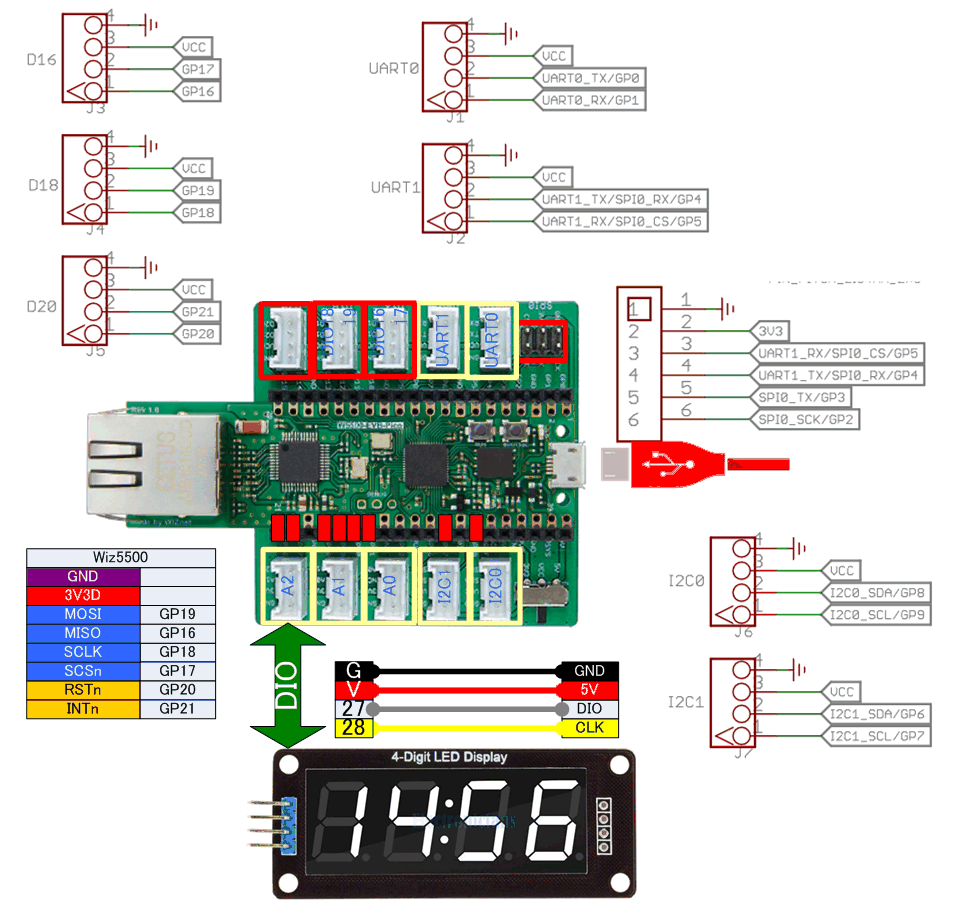/*
* 2023/03/13 T.Wanibe
* Udp NTP Client
* ネットワーク タイム プロトコル (NTP) タイム サーバーから時刻を取得する
* UDP sendPacket および ReceivePacket の使用方法を示します
* NTP タイム サーバーとそれらとの通信に必要なメッセージの詳細については、
* http://en.wikipedia.org/wiki/Network_Time_Protocol を参照
* 最大1044480バイトのフラッシュメモリのうち、スケッチが61332バイト(5%)を使っています。
* 最大262144バイトのRAMのうち、グローバル変数が8096バイト(3%)を使っていて、ローカル変数で254048バイト使うことができます。
*/
#define TIMER_INTERRUPT_DEBUG 1
#define _TIMERINTERRUPT_LOGLEVEL_ 4
#include "RPi_Pico_TimerInterrupt.h"
#include "TM1637.h"
#include <SPI.h>
#include <Ethernet3.h>
#include <EthernetUdp3.h>
#define SEG_DP 0x80
#define ON 1
#define OFF 0
#define TIMER0_INTERVAL_MS 1000
#define SPI_SCK 18
#define SPI_RX 16
#define SPI_TX 19
#define SPI_CS 17
#define NICReset 20
#define CLK 28 //pins definitions for TM1637 and can be changed to other ports
#define DIO 27
#define HTTPport 80
#define TELNETport 23
#define NTPport 123
#define SerialRate 115200
// コントローラの MAC アドレスと IP アドレスを以下に入力します。
// IP アドレスは、ローカル ネットワークによって異なります。
// ゲートウェイとサブネットはオプションです。
byte mac[] = {0x00,0x08,0xDC,0x54,0x4D,0xE0}; //WIZNET
byte ip[] = {192, 168, 0, 210};
byte dns_server[] = {192, 168, 0, 1};
byte gateway[] = {0, 0, 0, 0};
byte subnet[] = {255, 255, 255, 0};
int8_t TimeDisp[] = {0x00, 0x00, 0x00, 0x00};
unsigned char ClockPoint = 1;
unsigned char Update;
unsigned char halfsecond = 0;
unsigned char second;
unsigned char minute = 0;
unsigned char hour = 12;
static int8_t tube_tab[] = {0x3f, 0x06, 0x5b, 0x4f,
0x66, 0x6d, 0x7d, 0x07,
0x7f, 0x6f, 0x77, 0x7c,
0x39, 0x5e, 0x79, 0x71
}; //0~9,A,b,C,d,E,F
unsigned int localPort = 8888; // local port to listen for UDP packets
char timeServer[] = "time.nist.gov"; // time.nist.gov NTP server
const int NTP_PACKET_SIZE = 48; // NTP time stamp is in the first 48 bytes of the message
byte packetBuffer[ NTP_PACKET_SIZE]; //buffer to hold incoming and outgoing packets
int timeZone = int(9.0 * 3600);
// UDP 経由でパケットを送受信できるようにする UDP インスタンス
EthernetUDP Udp;
TM1637 tm1637(CLK, DIO);
RPI_PICO_Timer ITimer0(0);
//--------------
void custom_display(uint8_t bit_addr, uint8_t seg_data) {
tm1637.start();
tm1637.writeByte( 0x44 );
tm1637.stop();
tm1637.start();
tm1637.writeByte(bit_addr | 0xc0);
tm1637.writeByte(seg_data);
tm1637.stop();
tm1637.start();
tm1637.writeByte(tm1637.cmd_disp_ctrl);
tm1637.stop();
}
//--------------
void TimeUpdate(void) {
tm1637.point(POINT_OFF);
TimeDisp[0] = hour / 10;
TimeDisp[1] = hour % 10;
TimeDisp[2] = minute / 10;
TimeDisp[3] = minute % 10;
if (ClockPoint) {
custom_display( 0, tube_tab[TimeDisp[0]]);
custom_display( 1, tube_tab[TimeDisp[1]] | SEG_DP);
custom_display( 2, tube_tab[TimeDisp[2]]);
custom_display( 3, tube_tab[TimeDisp[3]]);
} else {
custom_display( 0, tube_tab[TimeDisp[0]]);
custom_display( 1, tube_tab[TimeDisp[1]]);
custom_display( 2, tube_tab[TimeDisp[2]]);
custom_display( 3, tube_tab[TimeDisp[3]]);
}
Update = OFF;
}
//---------指定されたアドレスのタイム サーバーに NTP 要求を送信します
void sendNTPpacket(char* address){
// バッファ内のすべてのバイトを 0 に設定します
memset(packetBuffer, 0, NTP_PACKET_SIZE);
// NTP リクエストを形成するために必要な値を初期化します (パケットの詳細については、上記の URL を参照してください)
packetBuffer[0] = 0b11100011; // LI, Version, Mode
packetBuffer[1] = 0; // Stratum, or type of clock
packetBuffer[2] = 6; // Polling Interval
packetBuffer[3] = 0xEC; // Peer Clock Precision
// 8 bytes of zero for Root Delay & Root Dispersion
packetBuffer[12] = 49;
packetBuffer[13] = 0x4E;
packetBuffer[14] = 49;
packetBuffer[15] = 52;
// すべての NTP フィールドに値が与えられたので、タイムスタンプを要求するパケットを送信できます:
Udp.beginPacket(address, NTPport); //NTP requests are to port 123
Udp.write(packetBuffer, NTP_PACKET_SIZE);
Udp.endPacket();
}
//----------------
void setup(){
tm1637.set(7); //0..7
tm1637.clearDisplay();
pinMode(LED_BUILTIN, OUTPUT);
digitalWrite(LED_BUILTIN, HIGH);
// シリアル通信を開き、ポートが開くのを待ちます。
Serial.begin(SerialRate);
while (!Serial) {
; // シリアルポートが接続されるのを待ちます。
}
pinMode(SPI_CS,OUTPUT);
pinMode(NICReset,OUTPUT);
// イーサネット接続とサーバーを開始します。
SPI.setSCK(SPI_SCK);
SPI.setRX(SPI_RX);
SPI.setTX(SPI_TX);
SPI.setCS(SPI_CS);
SPI.begin();
// Ethernet.init(pin)を使用してCSピンを設定できます
Ethernet.setCsPin(SPI_CS);
Ethernet.setRstPin(NICReset);
digitalWrite(NICReset,LOW);
delay(10);
digitalWrite(NICReset,HIGH);
Ethernet.init(SPI_CS);
// イーサネットと UDP を開始する
Ethernet.begin(mac,ip);
Serial.print("server is at ");
Serial.println(Ethernet.localIP());
Udp.begin(localPort);
}
//----------------
void loop(){
sendNTPpacket(timeServer); // NTP パケットをタイム サーバーに送信する
delay(1000); // 返信があるかどうかを確認するのを待ちます
if ( Udp.parsePacket() ) {
// パケットを受信しました。そこからデータを読み取ります
Udp.read(packetBuffer, NTP_PACKET_SIZE); // read the packet into the buffer
//タイムスタンプは受信パケットのバイト 40 から始まり、4 バイトまたは 2 ワードの長さです。 まず、次の 2 つの単語を抽出します。
unsigned long highWord = word(packetBuffer[40], packetBuffer[41]);
unsigned long lowWord = word(packetBuffer[42], packetBuffer[43]);
// 4 バイト (2 ワード) を結合して長整数にします。これは NTP 時間 (1900 年 1 月 1 日からの秒数) です。
unsigned long secsSince1900 = highWord << 16 | lowWord;
Serial.print("Seconds since Jan 1 1900 = " );
Serial.println(secsSince1900);
// NTP 時間を毎日の時間に変換します。
Serial.print("Unix time = ");
// Unix 時間は 1970 年 1 月 1 日から始まります。秒単位では 2208988800 です。
const unsigned long seventyYears = 2208988800UL;
// 70年を引く:
unsigned long epoch = secsSince1900 - seventyYears;
// JST
unsigned long JST = epoch + timeZone;
// Unix 時間を表示:
Serial.println(epoch);
// 時、分、秒を出力します。効率の悪い記述です
Serial.print("The UTC time is "); // UTC はグリニッジ子午線 (GMT) の時間です。
Serial.print((epoch % 86400L) / 3600); // 時間を出力します (86400 は 1 日あたりの秒に相当します)
Serial.print(':');
if ( ((epoch % 3600) / 60) < 10 ) {
// 各時間の最初の 10 分間では、先頭に '0' が必要です
Serial.print('0');
}
Serial.print((epoch % 3600) / 60); // 分を表示します (3600 は 1 時間あたりの秒数)
Serial.print(':');
if ( (epoch % 60) < 10 ) {
// 毎分の最初の 10 秒には、先頭の '0' が必要です
Serial.print('0');
}
Serial.println(epoch % 60); // 秒を表示します
Serial.print("The JST time is "); // UTC はグリニッジ子午線 (GMT) の時間です。
hour = (JST % 86400L) / 3600;
Serial.print(hour); // 時間を出力します (86400 は 1 日あたりの秒に相当します)
Serial.print(':');
if ( ((JST % 3600) / 60) < 10 ) {
// 各時間の最初の 10 分間では、先頭に '0' が必要です
Serial.print('0');
}
minute = (JST % 3600) / 60;
Serial.print(minute); // 分を表示します (3600 は 1 時間あたりの秒数)
Serial.print(':');
if ( (JST % 60) < 10 ) {
// 毎分の最初の 10 秒には、先頭の '0' が必要です
Serial.print('0');
}
Serial.println(JST % 60); // 秒を表示します
}
TimeUpdate();
// もう一度時間を尋ねる前に 10 秒待ってください
delay(10000);
}
